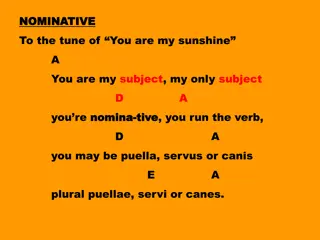
Latin Second Declension Nouns
Explore the second declension in Latin, focusing on nouns with masculine and neuter genders. Learn about the different cases and endings for nouns in this declension, such as nominative, accusative, genitive, dative, and ablative. Gain insights into how to identify and decline nouns in the second declension based on their gender and form.
Download Presentation

Please find below an Image/Link to download the presentation.
The content on the website is provided AS IS for your information and personal use only. It may not be sold, licensed, or shared on other websites without obtaining consent from the author. If you encounter any issues during the download, it is possible that the publisher has removed the file from their server.
You are allowed to download the files provided on this website for personal or commercial use, subject to the condition that they are used lawfully. All files are the property of their respective owners.
The content on the website is provided AS IS for your information and personal use only. It may not be sold, licensed, or shared on other websites without obtaining consent from the author.
E N D
Presentation Transcript
CHASE LATIN FOR MEDIEVALISTS AND EARLY MODERNISTS WEEK THREE: THE SECOND DECLENSION Sam McCarthy, University of Kent - slm73@kent.ac.uk This project is supported by the CHASE Doctoral Training Partnership
Case The case of a noun demonstrates the job that it is performing in a sentence. Nominative, accusative, genitive, dative, and ablative WHAT ARE THE ATTRIBUTES OF NOUNS? Number Singular or plural. Gender Grammatical gender Masculine, feminine, or neuter.
Nominative The nominative names the subject of the sentence or clause. Accusative The accusative is the case of the direct object. Genitive of WHAT DO CASES DO? Most commonly, the genitive communicates possession. Dative The dative is the case of the indirect object. to / for Ablative The ablative case is used to express separation, motion away from, manner, location, agency and instrumentality. from / with / in / by
DECLENSIONS A declension is a group of nouns that follow the same pattern of inflection. Each declension has its own set of endings to express the different cases and numbers. When you look a noun up in the dictionary, it will give you the nominative singular form, the genitive singular form, and the gender of the noun. This provides you with all the information you need to understand how to decline it.
THE SECOND DECLENSION servus, serv m. (male) slave or servant verbum, verb n. word So, servus and verbum are the nominative singular forms of the nouns. serv and verb are the genitive singular forms. The ending of the gen sing tells us that these are nouns of the second declension. The second declension contains masculine and neuter nouns. Though there are very rare exceptions, each of these genders has its own pattern of declension.
THE SECOND DECLENSION Nouns of the second declension have slightly different endings depending on their gender. Here are the endings for the masculine: Singular -us ( ) -um - - - Plural - - s - rum - s - s Nominative Accusative Genitive Dative Ablative
THE SECOND DECLENSION And here are the endings for the neuter: Singular -um -um - - - Plural -a -a - rum - s - s Nominative Accusative Genitive Dative Ablative
MASCULINE EXAMPLE serv- servus, serv m. (slave or servant) Singular -us ( ) -um - - - serv Plural - - s - rum - s - s serv s Singular servus servum serv serv Plural serv serv s serv rum serv s Nominative Accusative Genitive Dative Ablative Ablative Nominative Accusative Genitive Dative
ANOTHER MASCULINE EXAMPLE puer- puer, puer m. (boy) Singular -us ( ) -um - - - puer Plural - - s - rum - s - s puer s Singular puer puerum puer puer Plural puer puer s puer rum puer s Nominative Accusative Genitive Dative Ablative Ablative Nominative Accusative Genitive Dative
NEUTER EXAMPLE verb- verbum, verb n. (word) Singular verbum verbum verb verb Plural verba verba verb rum verb s Singular -um -um - - - verb Plural -a -a - rum - s - s verb s Nominative Accusative Genitive Dative Nominative Accusative Genitive Dative Ablative Ablative
SOME EXAMPLES FOR PRACTICE discipulus, discipul , m. (student or disciple) magister, magistr , m. (teacher or master) canticum, cantic , n. (song) deus, de , m. (God or deity) v num, v n , n. (wine) agnus, agn , m. (lamb)


![READ [PDF] Dash diet Cookbook for beginners: 365 days of simple, healthy, low-s](/thumb/2057/read-pdf-dash-diet-cookbook-for-beginners-365-days-of-simple-healthy-low-s.jpg)



















